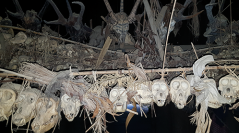

 Anthropozoologica
56 (13) - Pages 197-213
Anthropozoologica
56 (13) - Pages 197-213This article aims to highlight the modes of sociability that organize hunting practices and animal husbandry among the Mentawaians of Bat Rereiket Valley (Siberut, Indonesia). In that ethnographic context, these two activities are characterized by the simplicity of the technical devices. However, this simplicity contrasts with the complexity of the interactions that individuals intend to establish with animals, here the suidae. I intend to show that the hunting and “domesticatory” projects I have observed are based on a tour de force. Through the precise spatialization of the habitat, but also trough ritual gestures related to the conservation of the animals’ skulls, the Mentawaians lead to transmute predation-sacrifice practices into hospitality relationships. To do so, they mobilize the affectivity of the pigs, so as to arouse in them forms of attachment to the houses (uma). Through the architectural ornaments, and through the figurative strategies that govern their shaping, the article presents the way in which the Mentawaians strive to configure a hybrid space, both human and non-human.
Ontologies, reciprocity, figuration.